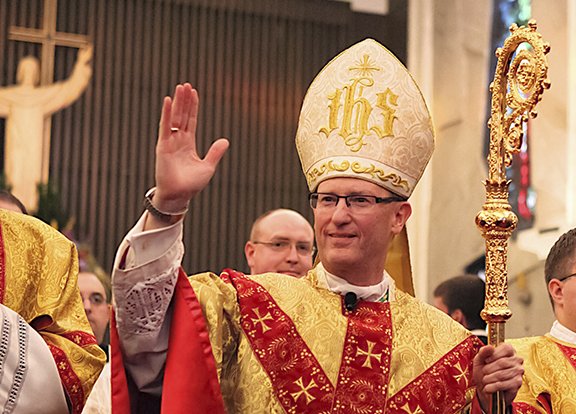
CNS PHOTO/KEVIN CLARK, SOUTHERN NEBRASKA REGISTER Bishop James D. Conley offers a blessing as he departs the Cathedral of the Risen Christ in Lincoln, Neb., after being installed as the ninth bishop of Lincoln on Nov. 20.
Bishop Conley succeeds Bishop BruskEwitz after 5 years in Denver
by Marc and Julie Anderson
mjanderson@theleaven.org
LINCOLN, Neb. — More than 1,200 people, including at least 40 bishops and archbishops, filled the Cathedral of the Risen Christ here on Nov. 20 to witness the installation of the diocese’s ninth bishop, Bishop James Douglas Conley, an Overland Park native who graduated from Shawnee Mission West High School in 1973 and the University of Kansas in 1977.
At the opening of the Mass, Bishop Fabian Bruskewitz, who served as the diocese’s eighth bishop and apostolic administrator from 1992 to 2012 and is now retiring, welcomed all those in attendance and praised God for sending “a precious treasure in our new bishop.”
The apostolic nuncio to the United States, Archbishop Carlo Maria Vigano, then read an English translation of Pope Benedict XVI’s apostolic letter naming Bishop Conley to the position. In it, the pope reflected upon the 125th anniversary of the Diocese of Lincoln, the faithful service of Bishop Bruskewitz and the “apostolic zeal” of Bishop Conley.
The new bishop started his first homily as bishop of Lincoln on a light note, explaining that “I moved from Denver to Lincoln on Nov. 6 — exactly two weeks ago today. And in that time, I’ve experienced my first Huskers victory and my first Runza sandwich, and both are pretty awesome.”
“I’ve also eaten more kolaches than I care to admit,” he continued. “But with those things behind me, I think it’s fair to say I’m now a Nebraskan.”
Later, turning his attention to the day’s celebration, the bishop said: “Today we celebrate the installation of a bishop. . . . But the focus of today’s Mass is not the installation of a bishop. The focus of the Mass and the focus of every Mass is the redeeming sacrifice of Christ on the altar, the Lord truly made present to us.”
Elsewhere in his homily, Bishop Conley discussed the relevance of the Sacred Heart of Jesus in the life of the church, bishops, priests, religious and the laity, as well as in his own vocation.
“Today we celebrate the votive Mass of the Sacred Heart of Jesus. In the preface to the eucharistic prayer we will pray in a few moments, we give thanks to God who ‘gave himself up for us with a wonderful love and poured out blood and water from his pierced side, the wellspring of the church’s sacraments, so that, won over to the open heart of the Savior, all might draw water joyfully from the springs of salvation.’ This wonderful love wants to win over our hearts,” Bishop Conley said.
Greeting the bishops in attendance, Bishop Conley reflected upon their shared responsibilities: “My brother bishops, there is nothing more important for a bishop than the care of souls. If the church is to flourish in the world today, if the new evangelization is to really take root, if we are to build a culture of life, holiness must begin with us.”
Elsewhere in his homily, he said that, like many priests, he attributes his vocation to Blessed John Paul II.
“In 1979, on a bright autumn day much like today, I stood in a cornfield not far from here in Des Moines, Iowa, as the new pope celebrated Mass on the feast of St. Francis of Assisi. His message was beautiful, especially because it was rooted in the spirituality of rural life.”
“But John Paul’s witness was more important this message,” he continued. “Even by 1979, John Paul’s life was characterized by suffering under the Nazis and then the Soviets, through the death of his mother and his father, his brother. I was 24 years old in October of 1979, and I watched a man whose life was defined by suffering but who, at the same time, radiated joy and hope.”
At the time, Blessed John Paul II was 59 years old. Bishop Conley recalled that he was energetic and joyful.
“St. Irenaeus said, ‘The glory of God is man fully alive.’ John Paul was fully alive in his priesthood, and I wanted to share in that life,” he added.
Reflecting upon his collaboration with the priests of the diocese, Bishop Conley said, “Our priesthood should be characterized by joy. Our sufferings can transform our hearts into the Sacred Heart of Jesus. They can allow us to love as Christ loved.”
Near the end of his homily, the bishop turned his focus to the laity of the diocese.
“In your daily lives, God has given you the opportunity to become holy,” he said. “Family life, professional life, your social and cultural and public lives are all venues for love and sacrifice. You are called to love with self-giving love, the self-giving love of Jesus.”
Bishop Conley quoted Archbishop Charles Chaput of Philadelphia who said recently, “The only thing that matters is to be a saint.”
“That’s what we need to be,” the new bishop continued. “That’s what we need to become.
“Your holiness can transform the world.”






